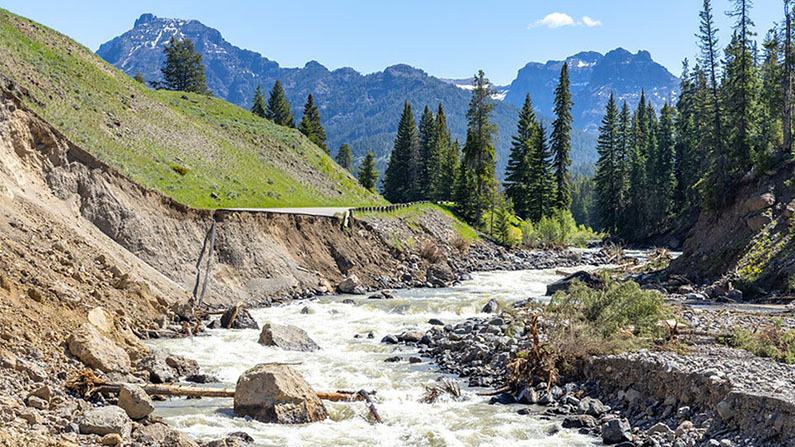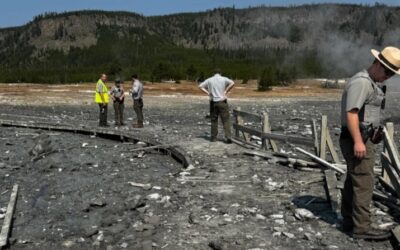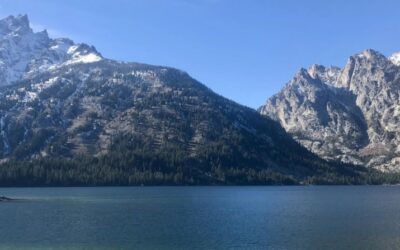This story comes to KHOL through a content-sharing relationship with Wyoming Public Radio.
Last month Yellowstone National Park and surrounding areas received historic flooding, river levels rose so fast and so high in Yellowstone that much of the park flooded. Creeks and rivers expanded onto the shore destroying roads and bridges along the way. A log cabin for employees even fell into the river.
Even a month later, parts of eastern Wyoming and southwest Montana are still experiencing some flooding.
But at the same time, much of the West is burning. Last year, more than seven million acres of land burned. The West is considered to be in a 22-year-long drought.
So, how can there be historic flooding when there is also a historic lack of water?
“It’s just always important to remember that weather and climate are two different things,” Erin Whorton, a water supply specialist for the Natural Resources Conservation Services, said. “Weather is like what’s happening on, you know, a more daily basis and climate is what the overall trend is.”
The drought that the West is in is considered a climate trend – it is long-term. But the flooding in Yellowstone was a weather event – which is short-term. Specifically, Whorton said the flooding occurred because of something called an ‘atmospheric river.’
“Which means there’s like this narrow band of really intense moisture that concentrated over that area, you know, it starts in the tropics, and it moves through the Pacific Northwest across through the Seattle area and then eventually reached Yellowstone,” Whorton said. “So, you’re getting a lot of water deposits at the same time.”
Atmospheric rivers usually happen on the West Coast and are quite rare inland, and when they do come to places like Wyoming it is usually during winter, causing heavy, wet snowfall. But, if an atmospheric river comes in the spring it causes rain.
“So the fact that the moisture was subtropical in nature meant that the temperatures that came with it were pretty mild,” Alan Smith, a Jackson-based meteorologist, said. “And that led to rain across even the highest elevations.”
That warm rain was falling on to an above average snowpack. Even though our region had a relatively dry and mild winter, a cold, wet spring made up for it. Smith said some areas had double the snowpack averages by early June.
Warm temperatures and high amounts of rain falling onto lots of snowpack created the perfect storm.
“You factor in the amount of rain that fell out of the sky and the amount of liquid that melted out of the snowpack as a result of that,” Smith said. “And you just had a ton of water flowing down these rivers into these canyons, which led to the flooding and the runoff.”
In a more typical year where the snow falls mostly in the winter, temperatures rise gradually and there are no extreme rain events, Whorton said the Rocky Mountain region would not see flooding like it did in Yellowstone.
“A big snow year slowly melting off is going to have this normal sort of mid-summer peak streamflow because if it’s coming off slowly, your river is going to rise a little bit more slowly,” she said. “You’re going to peak when you’re getting the maximum amount of runoff and then it’s going to slowly decline.”
Smith added that even in a drought there can still be an increase in precipitation at certain times of the year.
“Suddenly you have a huge storm system that dumps a lot of rain, it doesn’t matter how dry or wet the preceding conditions were to that event, if you have that amount of moisture coming out of the sky all at once you can have flooding even while you’re in a drought,” he said.
Smith said he would not be surprised if more flooding events happen in the future, because with drought comes warmer temperatures.
“That could lead to more rapid snow melts,” Smith said. “And if you throw some heavy rain, like what we saw recently on top of the melting snowpack in the spring, we could certainly have more flooding events as well.”
He added that the flooding actually helped move most of Yellowstone out of drought status, as previously it had been in ‘abnormally dry’ to ‘moderate drought’ status. However, much of Wyoming is still in moderate to extreme drought.





